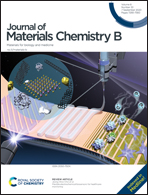Disposable multiplexed electrochemical sensors based on electro-triggered selective immobilization of probes for simultaneous detection of DNA and proteins†
Abstract
Electrically addressable covalent immobilization of probes on a multiplexed electrode for the simultaneous detection of multiple targets within the same sample is often regarded as a difficult milestone to be achieved. Herein, we demonstrated a reagentless disposable multiplexed electrochemical DNA and aptamer-based sensing platform for the simultaneous determination of various targets. The electrochemically triggered “click” chemistry was developed, and three biomarkers, including p53, thrombin, and VEGF165 were used as model analytes. The proposed sensor consisted of three independent screen-printed carbon electrodes (SPCE), with an alkyne–azide cycloaddition reaction that was activated selectively by means of electrical triggering, so that different DNA probes can be modified on the desired electrode units in sequence. In terms of simultaneous detection, the sensor was able to quantify the DNA target of p53 with a detection limit of 0.35 nM, whereas the limits of detection for protein quantification of thrombin and VEGF165 were 0.22 nM and 0.014 nM, respectively. The proposed sensor not only showed encouraging reproducibility and stability, but also performed well even in 50% serum samples. Therefore, the work described here offers a general strategy for developing a multiplexed sensor with promising potential to achieve rapid, simple and cost-effective analysis of biological samples.



 Please wait while we load your content...
Please wait while we load your content...